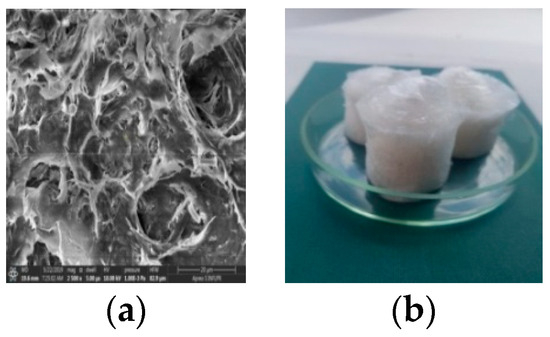Cellulose is the most abundant renewable biopolymer in nature, being the main constituent of plant cell walls [1]. Nanocellulose is a new class of biomaterial, with numerous biomedical applications due to its unique properties, such as biocompatibility, biodegradability, and good mechanical properties [2]. This study aimed to obtain 3D porous structures based on nanocellulose and PEG-based monomers/oligomers.
The obtained grafted cellulose aerogels were characterized by Brunauer-Emmett-TellerBET surface area analysis to observe the increased porosity and high specific area. Grafting of cellulose nanofibers is seen in the modification of the FT-IR spectrum by the appearance of new peaks and bands with high intensity. Due to these properties, the obtained cellulose composite aerogels (Figure 1) can be potentially used as scaffolds for tissue regeneration or as drug delivery systems.

Figure 1.
(a) SEM image of cellulose fiber coated with PEG-based monomers and (b) image of cellulose foams.
Acknowledgments
This work was supported by a grant of the Ministry of Research and Innovation, CNCS–UEFISCDI, project number PN-III-P4-ID-PCE-2016-0431, within PNCDI III, contract no. 148/2017 (CELL-3D) and contract 23N/2019, PN 1923020104.
References
- Coseri, S. Cellulose: To depolymerize… or not to. Biotechnol. Adv. 2017, 35, 251–266. [Google Scholar] [CrossRef] [PubMed]
- Pereira, B.; Arantes, V. Nanocelluloses from Sugarcane Biomass. In Advances in Sugarcane Biorefinery, Technologies, Commercialization, Policy Issues and Paradigm Shift for Bioethanol and By-Products, 1st ed.; Chandel, A.K., Luciano, S., Eds.; Elsevier: Atlanta, GA, USA, 2017; p. 342. [Google Scholar]
© 2019 by the authors. Licensee MDPI, Basel, Switzerland. This article is an open access article distributed under the terms and conditions of the Creative Commons Attribution (CC BY) license (http://creativecommons.org/licenses/by/4.0/).